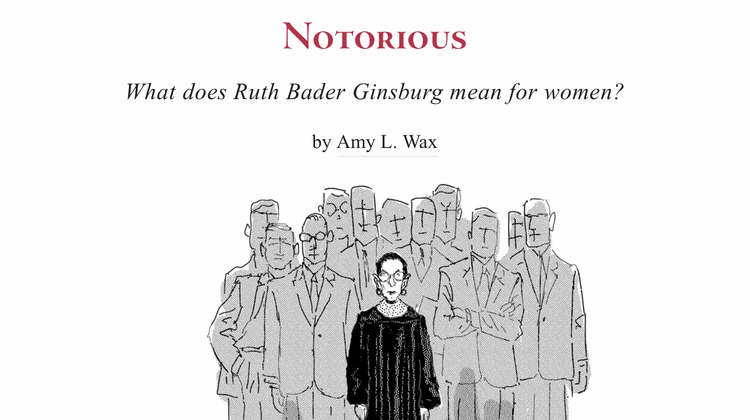


By Steve Sailer
09/20/2020
Amy Wax of the U. of Pennsylvania law school wrote an insightful article about RBG earlier this year for the Claremont Review of Books. In Wax’s telling, Ginsburg was a brilliant workaholic, able to go head to head with the smartest men, but most women (like most men) are not brilliant workaholics. This meant that Ginsburg was increasingly irrelevant during the Great Awokening when the issue became how to dumb down American life to the level at which black women could compete equally with Jewish men:
The tensions between Ginsburg’s example and the reality, between feminist aspirations and most women’s lives, and between incremental progress and dramatic transformation, are indicative of larger fault lines in feminism that Ginsburg has barely addressed in her career, writings, or opinions. Ginsburg has always been primarily an “equity feminist.” She has pushed for formal equality and for greater access to arenas from which women were previously excluded, expecting greater access to yield greater parity. She proceeded in this way because she envisioned women as a match for men not just in legal formalisms, but in outcomes and roles. Yet despite pushing conventional limits and challenging gender stereotypes at home and at work, she favored a targeted legal path to fixing gender inequality, not a revolutionary transformation of all aspects of society. She had little interest in recasting basic institutional design or disrupting workplace hierarchies: she accepted longstanding, conventionally masculine standards for education, legal procedure, analysis, and argumentation. In a speech to women judges in 1986, she argued against preferences and special treatment for women in such areas as pregnancy and child rearing, warning that those efforts would reinforce stereotypes. In these respects, at least, she wanted women to be more like men.
And though she is frequently billed as a pragmatist, Ginsburg in her writings reveals an optimistic, idealistic vision of harmoniously egalitarian families, political precincts, and workplaces. Without ever confronting the question deeply or directly, she implicitly accepts the basic premises of blank-slate progressivism: that the present realities of gender, including women’s and men’s differing preferences, choices, capacities, and desires, are the remnants of a benighted and oppressive past that can be vanquished and eliminated by getting law and policy right. She has often asserted that such reforms would benefit both sexes, so that her quest for women’s rights is also one for human rights. But this win-win conception carries limitations and creates blind spots. Fueled by her own fortunate situation and the insular elite domains she occupies, Ginsburg has failed to confront the real tradeoffs that might be entailed in expanding women’s rights. She has never stopped to consider that the nature of womanhood and the intricacies of family relations might impede equality of outcomes, or that interchangeable roles for men and women might not be attainable, or even desirable, for the great majority of people of either sex.
In recognition of these insights, there emerged in the 1980s a different strain of feminism from the one Ginsburg championed. Designated “difference feminism,” this alternative philosophy acknowledges women’s unique vulnerabilities, traits, and needs, calling upon society to recognize, accommodate, and even cater to the ways in which women are not exactly like men. Within the legal profession itself, the contrast between equity and difference feminism was presaged, strikingly, by the government’s argument in the VMI case. The state proposed that a separate military education program be developed at Mary Washington College as a gentler and less “adversative” substitute for the rigorous demands of a VMI education. In his counterargument, Deputy Solicitor General Paul Bender cast aspersions on the state’s assertion that women couldn’t handle the harsh regime at VMI. On the very same logic, he suggested, “a new women’s law school” would have to be set up with “a much warmer, a much more embracing environment” — a notion, he implied, both risible and demeaning.
But ironically, quite similar proposals were advanced in the same year by feminist Lani Guinier, now a Harvard Law professor, in a University of Pennsylvania Law Review article. According to Guinier, the Socratic method, with its emphasis on logic, rigor, fine analytic distinctions, and public performance, was personally intimidating and psychologically traumatic for women. Male-oriented pedagogical techniques interfered with women’s ability to learn and accounted for the then-measured gaps between males and females in law school performance, class participation, and subjective self-evaluations. Guinier urged law schools to adopt more “female-friendly” educational methods that were better suited to women’s wants and needs. Unlike Ginsburg, who demanded entry to male precincts and permission to perform on men’s terms, Guinier asked that the contours of the field, and the playbook for the game, be radically revised. This same impulse has now motivated calls to revise basic rules in politics, science, the entertainment industry, the military, journalism, and other male-dominated workplaces.
The future of women in American society will undeniably be shaped by how it responds to these demands, and how that response affects men’s and women’s lives. Ruth Bader Ginsburg, for her part, has mostly avoided grappling with difficult questions about the nature and source of sex differences, their malleability or intransigence, and their implications for the world of work, sexual relations, and family. Despite RBG’s many successes, these questions remain her legacy for future generations to address. They will be with us for a long time.
Amy L. Wax is the Robert Mundheim Professor of Law at the University of Pennsylvania Law School.